The African dwarf mud turtle, Pelusios nanus, has been sporadically imported into the United States for the past eight years, making it one of the newer species in captivity here.
African dwarf mud turtles of the genus Pelusios are, in one sense, very familiar to American reptile keepers. These turtles have been imported for many years to be sold as pets at an affordable price. They are often kept in aquariums with other commonly kept species from around the world despite the fact that they have unique needs and natural history. Commonly kept Pelusios species are often not given much thought and despite how widely kept the Pelusios genus is, these turtles also remain quite poorly known regarding their specific needs in captivity.
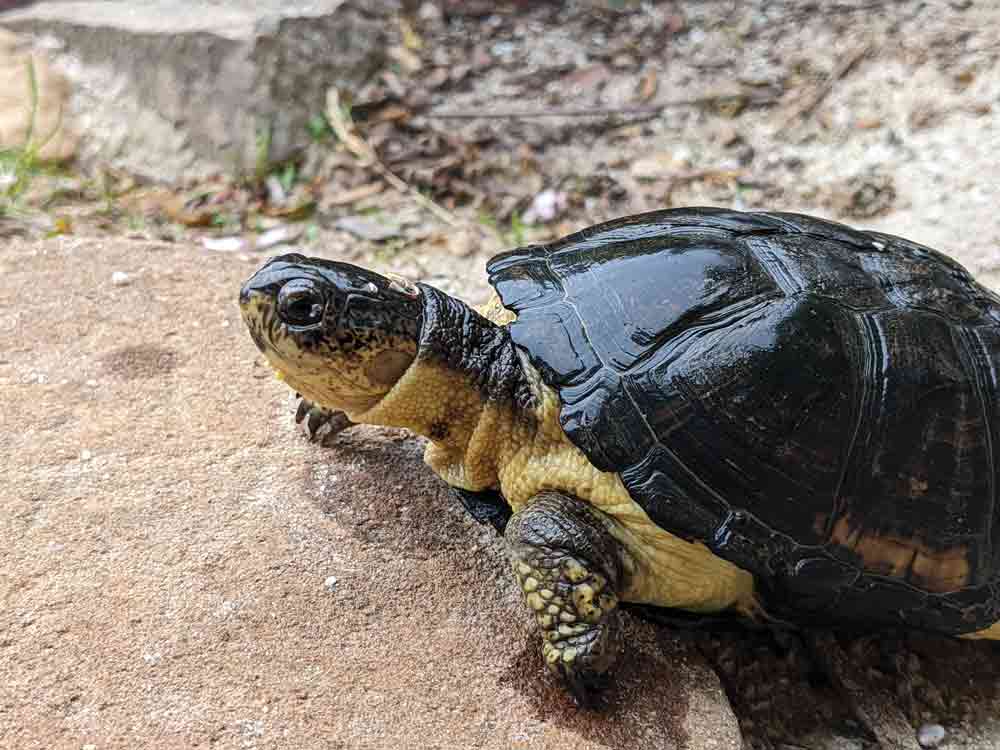
This is the smallest turtle of its genus, at just 12 cm straight carapace length (SCL) in adults. Photo by Anthony Pierlioni
Another African turtle, the helmeted turtle, of the genus Pelomedusa is also often imported and differentiating the two taxa can be difficult. Recognizing the specific species of the Pelusios genus is even more difficult, so the animals often show up on identification forums and social media groups. The genus is also poorly understood in terms of the 16 different species within it.
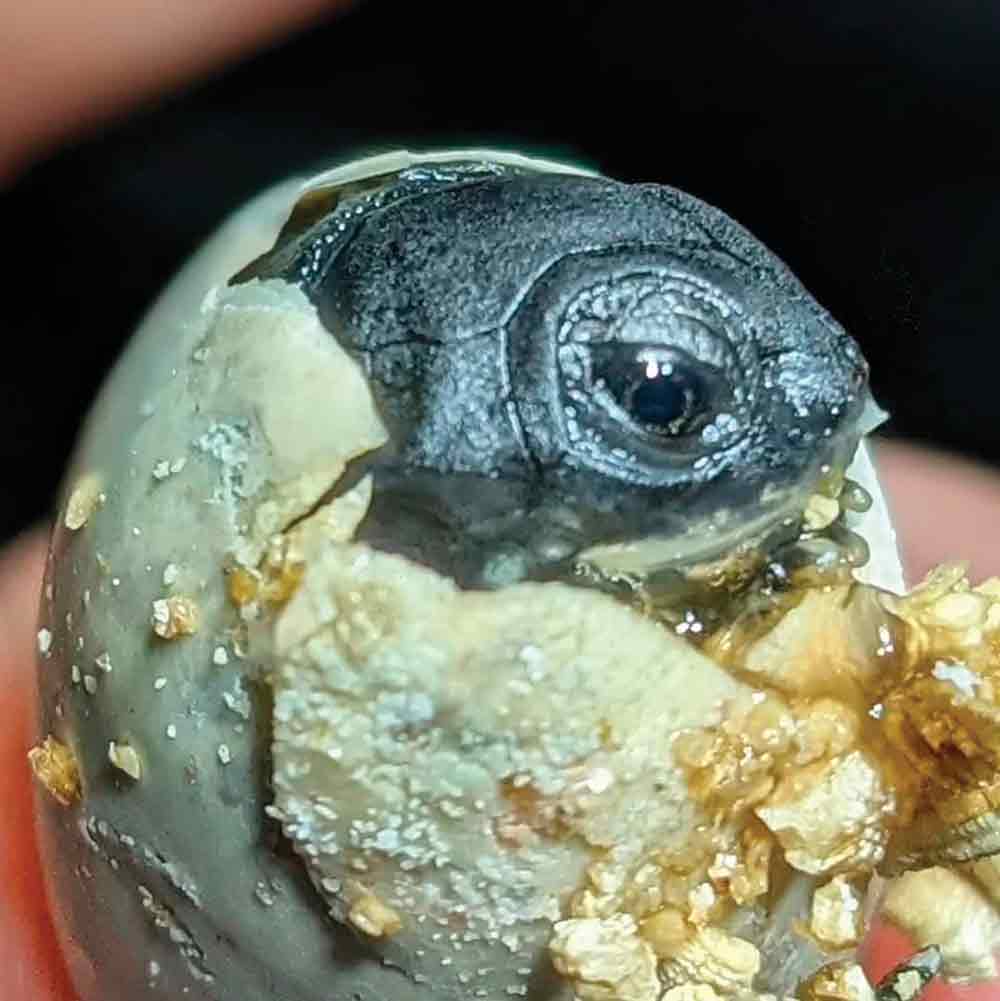
Hatchlings are very small. Photo by Anthony Pierlioni
One Pelusios species, however, has taken the turtle side of herpetoculture by storm since it first began to be imported around 2014. For turtle keepers, considering pros and cons of a species one might work with is imperative. Things like cold tolerance, ease of care, and reproductive output or fecundity are often evaluated. Many keepers consider adult size to be as great a factor as any when determining which species best fits plans for captive breeding programs.
African Dwarf Mud Turtle History in the Trade
The African dwarf mud turtle, Pelusios nanus, has been sporadically imported into the United States for the past eight years, making it one of the newer species in captivity here. As it is still a relatively new species to science, this turtle has never been a well-known, or even widely accepted species, even by Pelusios standards. There is very limited information regarding Pelusios nanus, both in captivity and in the wild. When the species was first being imported, we looked at the natural history and care of P. adansonii, the most closely related species.
The small size of Pelusios nanus definitely has made it an instant source of intrigue for many Western hobbyists. Many keepers work with limited resources and for that reason, the diminutive and unique P. nanus cannot be ignored. I first saw this species in Bonin’s “Turtles of the World,” and was immediately drawn to the small adult size and endearing face of the species. Imagine my excitement when I first saw the species offered for sale. The initial asking prices, although fair for a species virtually never offered for sale, were pretty substantial, keeping me from buying them all.
African Dwarf Mud Turtle Description
This is the smallest turtle of its genus, at just 12 cm (4.7 inches) straight carapace length (SCL) in adults. This distinction earns this turtle both its common and scientific names, “dwarf” and “nanus.” The moderately-sized head of Pelusios nanus has a short snout. The upper jaw is slightly notched and there are two tubercles on the underside of the chin. The shell is elongated and oval in shape, there is no vertebral keel, and the posterior of the carapace may be slightly flared.
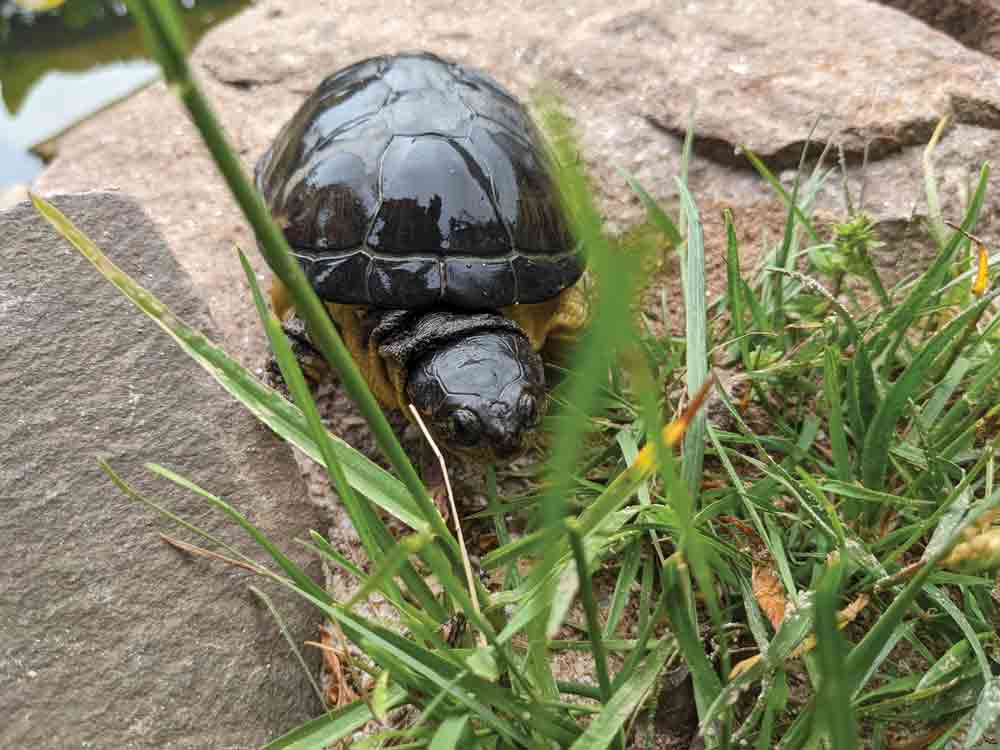
The natural history and wild situation of this species is poorly known. Photo by Anthony Pierlioni
The plastron is large, with a weak hinge and is narrow at the abdominal-femoral seam. Males display plastral concavity and are smaller than the already-miniature females, with a large tail that they keep tucked to the side. The carapace is usually a dull brown or black color, sometimes with faint streaks. We have seen new growth around the costal scutes in captive animals that boasts an attractive, lighter color. Forelimbs in this species lack large transverse scales. The skin of populations originating in the Congo are reported to be a rich, yellow color. Our animals have this coloring and are reported to originate from said locale, which seems to be the case with many imports.
African Dwarf Mud Turtle Natural History
The natural history and wild situation of this species is poorly known. The history of the taxon, particularly regarding this species is also of note. Loveridge (1941) revised the family of Pelomedusa, reducing the entire genus to only four species; Pelusios adansonii, P. gabonensis, P. subniger, and P. sinuatus. Laurent (1956) added four more species to the genus, including Pelusios nanus, a declaration that would be rejected in the future by Wermuth and Mertens (1961). After the validity of his findings were questioned, Laurent worked to provide more convincing evidence. One method was using logarithms to decipher a multitude of measurements from animals at natural history museums from around the world.
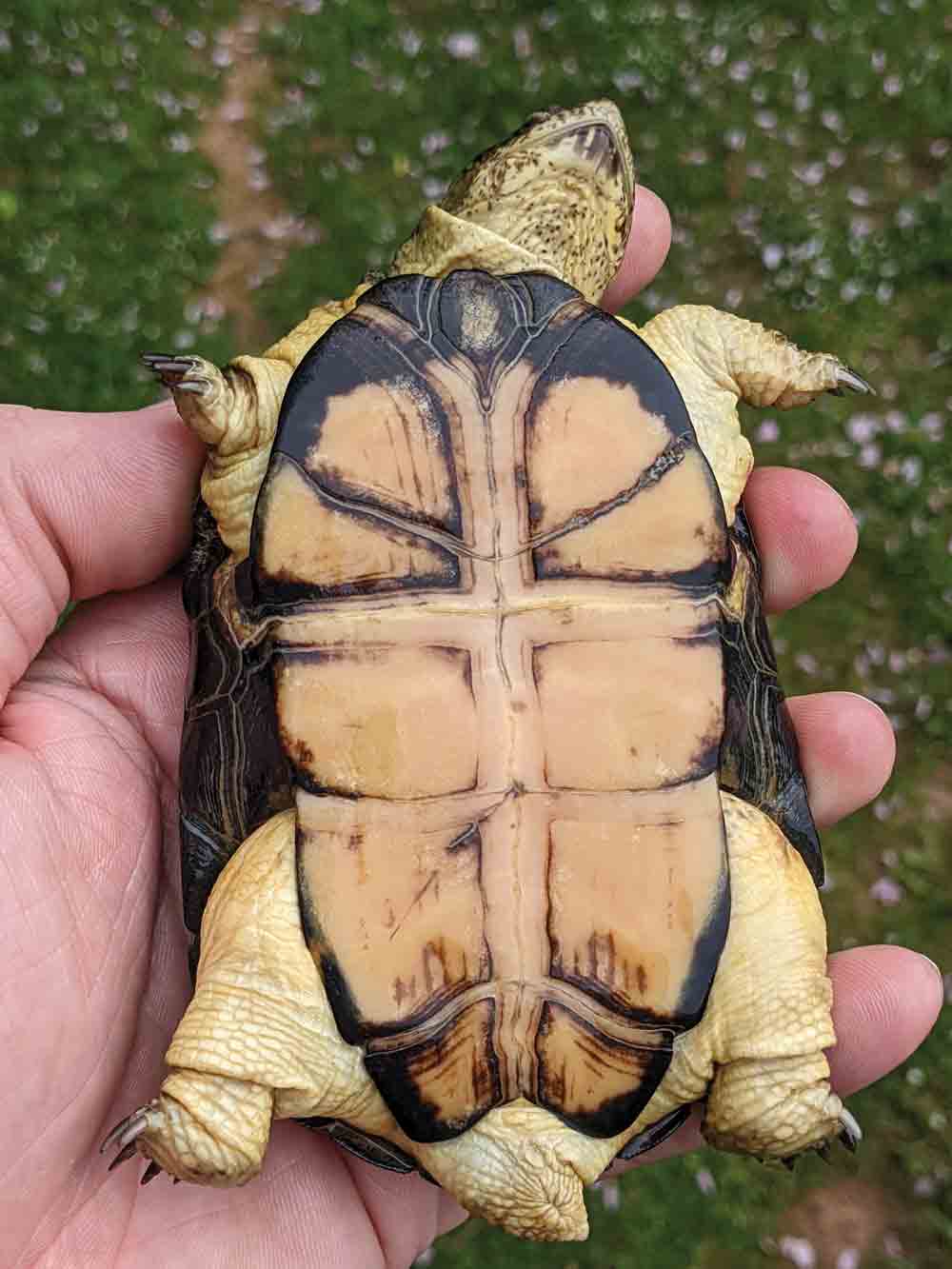
The plastron of the African dwarf mud turtle. Photo by Anthony Pierlioni
The African dwarf mud turtle, Pelusios nanus, was once thought to be a southern representative of Pelusios adansonii. Two of the strongest voices on this topic, Wermuth and Mertens (1961) thought that these two species were one in the same, though data and evidence backing these claims were lacking. Laurent (1965) examined these two species closely, finding them to be quite different from one another, from external morphology alone. The general shape and color are unlike one another. Pelusios nanus (12 cm) is also quite smaller than P. adansonii (17 cm). The differences between the width of the third and fifth vertebral scutes and the width of the intergulars also distinguish the two species.
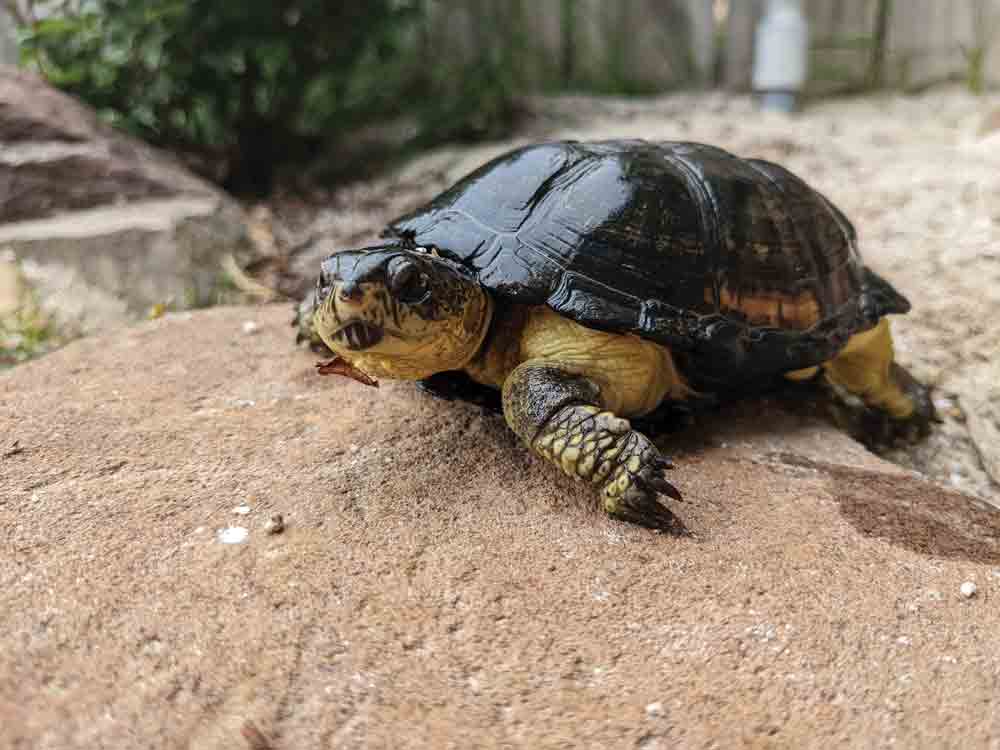
The African mud turtle came into the hobby around 2014. Photo by Anthony Pierlioni
In the wild, this small turtle inhabits small bodies of water in humid savannas. Pelusios nanus serves the same ecological purpose in southern portions of Africa, specifically in the Zambezi, the Congo, and Angola, as its northerly relative, P. adansonii.
Biology of P. nanus is very poorly known, despite their wide distribution. The species is thought to be easily overlooked in the wild, which leads to educated guesses that populations may be stable, but there is no real data backing that claim. During the dry season, the population in Zambia has been found to inhabit small ponds and it is not known whether or not this particular population aestivates at that time.
African Dwarf Mud Turtle Captive Care
We have had the opportunity to keep several groups of adult founders, as well as a handful of what were at one time some of the very first captive-produced Pelusios nanus in the United States. Hatchlings grow extremely quickly, while displaying some of the most aggressive feeding behavior imaginable. It would be hard to imagine such a small turtle running to a person for food, especially as aggressively as this species. Every morning, before most of my animals are even awake, I greatly enjoy looking on as these small turtles frantically swim/run toward me for food. In our experience, even fresh imports beg for food like captive-bred, adult red-eared sliders.
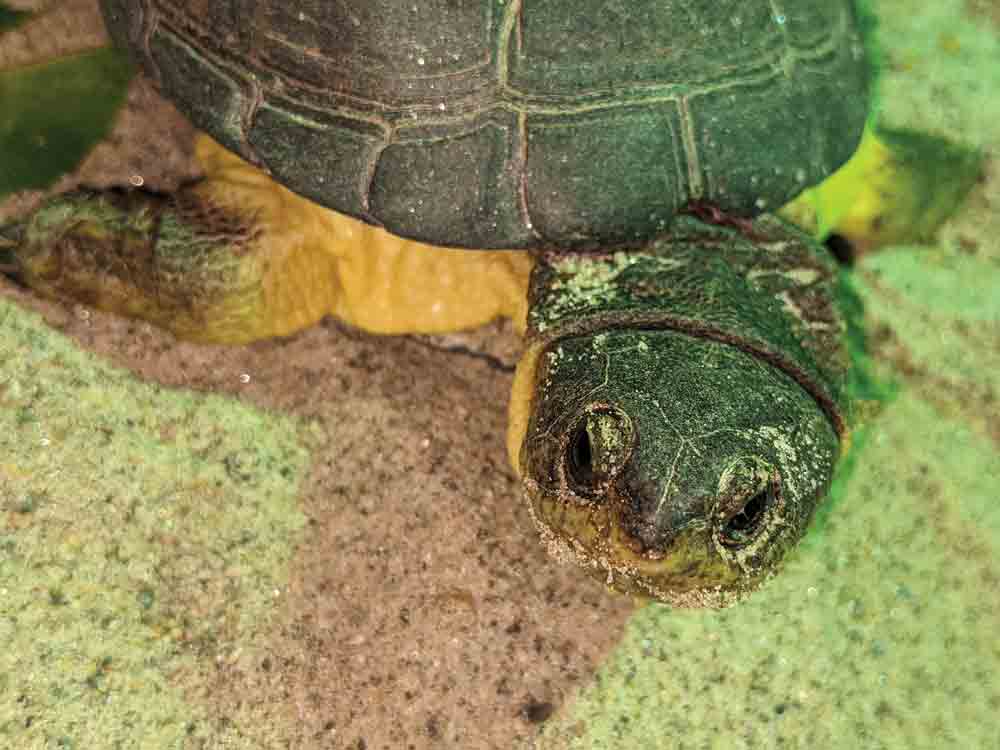
In the wild, this small turtle inhabits small bodies of water in humid savannas. Photo by Anthony Pierlioni
Our adult Pelusios nanus have been kept in Rubbermaid stock tanks ranging from 50 to 150 gallons and Waterland tub type enclosures, including the smaller Zoo Med tubs, depending on the size of the groups in which they are maintained. We have witnessed absolutely no aggression from this species, an important factor when determining best practice for assembling breeding groups and enclosure design. The one exception to this rule is that males will sometimes be a bit on the overzealous side when it comes to romantic advances toward their female counterparts.
Adults have been set up here with varying depth of water, sometimes as low as a couple inches and other times roughly 10 inches in depth. As the water depth increases, so too does the importance of designing spaces with lots of “furniture,” like driftwood and large pieces of PVC piping. For added security, we add some floating aquatic plants like water hyacinth. Stress is, afterall, the biggest threat for most captive chelonians. The substrate is rinsed play sand, which is offered as an egg laying medium in the terrestrial portion of the enclosure and that subsequently gets dragged into the water area.
Filtration can be rather straight forward. Since turtles generally produce more waste than fish, commercially available filtration for small to medium aquaria work wonderfully, but we recommend using filtration rated for at least double the amount of gallons in a given enclosure. These turtles are so small, their waste production does pale in comparison to other chelonians. They are turtles, however, so filtration is a great idea, especially when turtles are being kept in enclosures with egg laying areas, preventing “dump and fill” techniques.
Lighting has been provided by normal incandescent bulbs for heat, and a separate bulb for UVB radiation. Temperatures in the 80s are a nice standard, with a basking temperature in the low to mid 90s. While warm temperatures should be maintained whenever possible, it is important to mention that this species has had their temperatures at night drop as low as 57 degrees Fahrenheit (13.9 degrees Celsius) overnight in my care. This is not required and extreme temperature drops should be avoided.
African Dwarf Mud Turtle Breeding
Providing a nesting area for the adults is very important, which should come as no surprise to those keeping this species. The goal of virtually all P. nanus keepers is to breed the species. Luckily, this species is so small that common do-it-yourself techniques can be employed for this small turtle. A small tub can be suspended above the water surface, by stacking rocks, using plastic egg crate, or suspended on top of the walls of the enclosure, if it is shallow enough to keep the ramp a modest length. For substrate in the nesting area, we have used play sand and at times have mixed in peat moss or Zoo Med’s Eco Earth, which is made from coconut fiber. These nesting situations have proven useful in indoor setups for many species, including P. nanus. Commercial turtle tubs with nesting areas built in are also quite useful for this species.
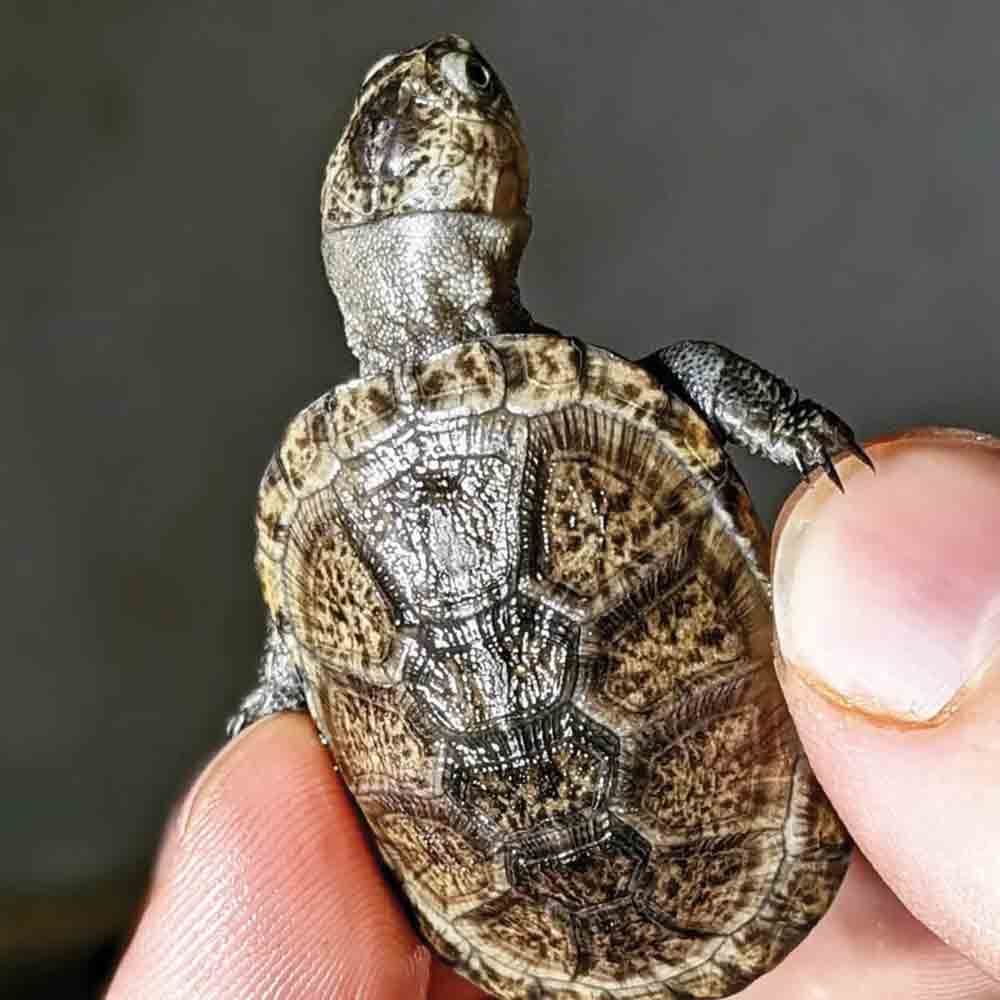
African mud turtles are very small turtles, with adults growing no more than 4 inches or so. Photo by Anthony Pierlioni
Nesting for our animals occur in the late summer or fall and seems to be consistent with what you would expect from other members of the genus, but with a twist. Females nest with their bodies pointing straight up, and almost completely buried beneath the surface. One might speculate that this adaptation is an accommodation that affords this diminutive turtle the opportunity to create nest chambers as deep as a normal turtle.
Clutch size produced by the animals in our care has ranged between four and six eggs. Successful incubation has been maintained in a warm room, without the use of an incubator, with relatively steady temperatures between 83 to 88 degrees Fahrenheit (28.3 to 31.1 degrees Celsius). Incubation periods have lasted between 55 and 59 days.
African Dwarf Mud Turtle Hatchling Care
Hatchlings are very small, which is to be expected. We set our hatchlings up in Sterilite tubs measuring 13 5/8” L x 8 1/4” W x 4 7/8” H, with an inch of water, fake plants and/or sphagnum moss and a basking platform. There is no filtration, so water must be changed every couple days to keep things clean. That being said, I have seen no indication that water quality is as important as with other species. Once or twice when food is not eaten, which may happen at cooler temperatures around the winter, the water has become a filthy green or brown color with entirely no ill effect.
To The Student in All of Us
For keepers or students interested in studying a species that has not been studied in great detail. this may be the animal for you. There are bigger fish to fry in the areas in which P. nanus occurs, where turtle biology, study, or appreciation is not a priority. It can be challenging and rewarding when working with unknown species like Pelusios nanus, or the sympatric Zambezi flap-shelled turtle, Cycloderma frenatum, for these reasons. Many of us cannot have experience with the large animals, like C. frenatum, which makes Pelusios nanus the best of both worlds. This project currently represents an opportunity to take notes on your turtle project that actually matter, because you may observe behaviors that have not been recorded yet.
Those of us with limited space do not have opportunities like this very often and with Pelusios nanus being as small as they are, they are a species that can easily be concealed in a dorm room! That speaks to the 20-year-old version of myself who hid the fact that I had alligator snapping turtles, Macrochelys (sp), living in my dorm room. A few years later, I hatched my first turtle eggs on a shelf in the closet of my childhood bedroom – spotted turtles, Clemmys guttata, before this tiny species became protected in my home state.
It was no coincidence that the first species I produced was a tiny species and that incredible experience would not have happened if that was not the case. These experiences help solidify certain species in herpetoculture for the long haul, so long as dedicated keepers can overcome low reproductive output of species like Pelusios nanus. Together, dedicated keepers can turn the tide so that future breeders can experience the joys of captive propagation of turtles, even in an apartment or bedroom. Dorm rooms are not recommended for a multitude of reasons.
Anthony Pierlioni is the Vice President of theTurtleRoom, an international turtle conservation organization. He also works in veterinary leadership and regional training. Anthony keeps and breeds numerous endangered turtle and tortoise species and works to educate the public about their plight. His book on the Geoemyda genus was published by Living Art Publishing in 2016. Anthony is also a host of the “Pondcast,” the world’s first turtle podcast, and “Turtley Devoted,” a show about turtles, the people who love them, and the people who love them. Follow him on Instagram and FaceBook.

